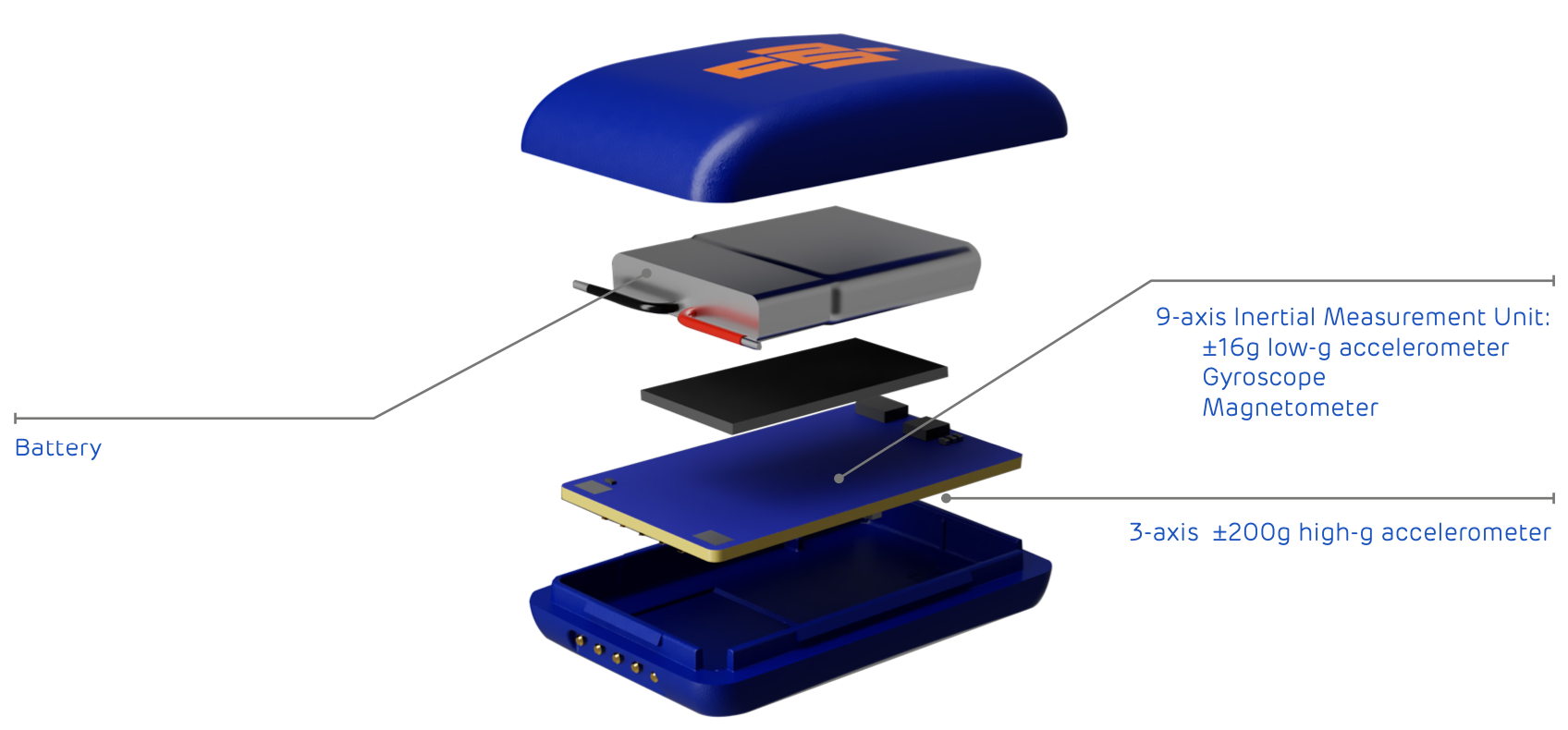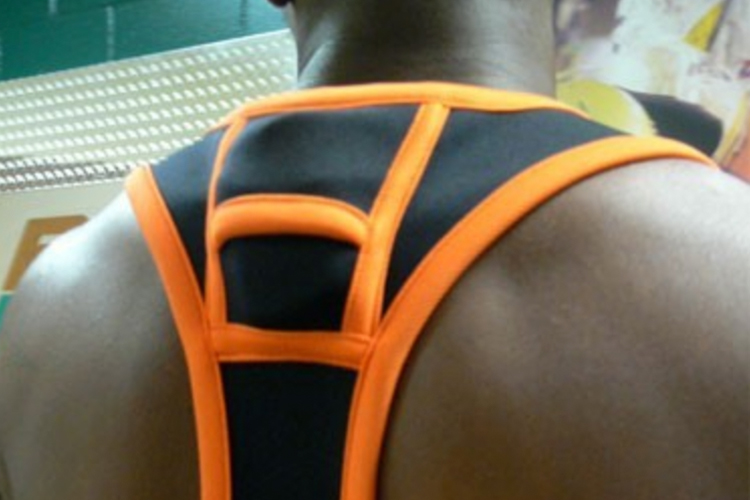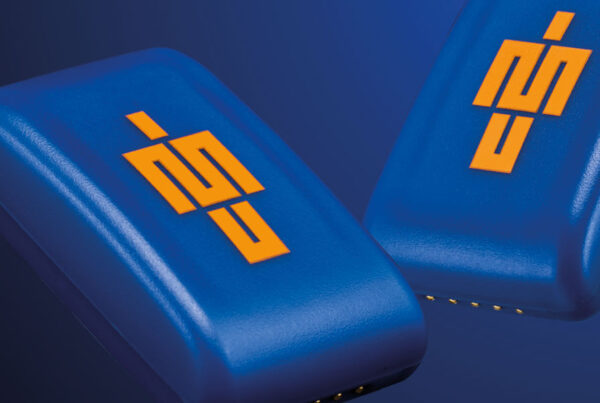
What is an inertial measurement unit?
Inertial measurement units (IMUs) have exploded in popularity over the last decade so that you can now find them in almost any sporting environment. An IMU is a collection of sensors, including an accelerometer, gyroscope and magnetometer. It collects data about the movement of the unit itself. Inertial measurement units collect raw, unfiltered data that many sports technology companies refine using algorithms and in-depth calculations to produce digestible metrics. The hardware itself is relatively cheap to manufacture. However, the algorithms and software applied to the raw data from the IMUs provide the real value to the end-user.
Accelerometers detect changes in acceleration to give detailed data on how something is moving in space.
Although distance and velocity measurements are useful in player-tracking technology, to get a real in-depth analysis of movement, practitioners often turn to inertial sensors. Rather than treating the body as a single unit, multiple sensors can give details on individual body parts or joints. These sensors collect data across three axes and capture athlete movement in minute detail.
One of the most used components within the inertial sensor is the accelerometer. Accelerometers detect changes in acceleration to give detailed data on how something is moving in space. Accelerometers are everywhere and are simple to manufacture. Simple ones are in our smartphones, our laptops, in cars, and in our wearable devices. Some high-end accelerometers can detect changes in acceleration to 1600 Hz, producing more than 1600 data points every second.
One common misconception is that the data collected via inertial sensors worn in between the scapula (predominantly in GPS devices) accurately reflects what is going on at the extremities such as the ankle and foot.

Applications for IMUs
IMUs are very versatile. They can be placed anywhere on the body and aren’t reliant on communication with outside sources. In the sporting and orthopedic world, this translates well into using the sensors for rehab. With a sensor on each leg, practitioners can detect changes in asymmetry throughout a return-to-play journey. If they also monitor their healthy athletes, they can compare an injured athlete’s progress to their own healthy data. IMUs can also measure a healthy athlete’s general loading pattern, providing a better window into what’s happening at each limb than a single, shoulder-worn sensor. They provide a load-monitoring solution in indoor and water sports, where access to a satellite is not possible.
Take as an example the common jumping sports issue of counting how many jumps that athletes actually perform. Traditionally, this has resulted in coaches manually counting jumps, which is extremely time-intensive. Recent research now suggests that sensors have the capabilities to automatically and reliably count the number of jumps an athlete performs. Especially when placed closer to the ground, IMUs can easily detect the accelerations associated with a jump. Their small size and sensitivity open up a whole world of applications that are missed with GPS systems alone.
Over recent years, concussions have received a lot of press attention, with some high-profile athletes retiring from such injuries. A number of governing bodies and associations are turning to sports technology companies that embed accelerometers within protective headgear. The aim of this is to try to quantify collisions. It is hoped that this will lead to sports scientists and performance coaches gaining a greater understanding of the demands being placed on their athletes so they can ensure their safety.
As data processing, algorithms and data management improves, the use of inertial sensors will become more popular in sports performance, especially as hardware continues to shrink. This may even result in inertial sensors being embedded into clothing. This will lead to further flexibility in the data that the coach collects.
With the rise of global positioning systems (GPS) over the last 10 years, coaches often forget about the accelerometer. The most up-to-date GPS devices collect data at 15–20 Hz, a fraction of the sample rate of the accelerometer. For staff and player buy-in and ease of understanding, practitioners gravitate towards what is termed ‘level 1 data’, such as total distance and what velocities the athletes reach. For example, player X ran 10 km and 500 m above 19.8 km/h.
But, as practitioners progress along their journey in using such systems, they often begin to see the limitations of this type of data. When they look to the accelerometer for deeper insights, they can then dive deeper into accelerations, decelerations, and stride characteristics.
As the field of athlete monitoring matures, stand-alone accelerometers from companies such as IMeasureU are beginning to replace traditional GPS setups in indoor sport and rehabilitation applications.

Athletes wear GPS devices on the upper back between the scapula, however coaches need to be cognisant of data quality due to this positioning.
What is a GPS device?
The GPS (Global Positioning System) is a US-owned, satellite-based navigation system that provides positioning, navigation, and timing to receivers on the ground. We commonly think of this as how our cars’ navigation devices work, but there are many more applications than this. When applied to athletics, satellites can track athlete’ speed and distance to give an idea of what they’ve done. Athletes wear devices on the upper back that send info that exchange information with these satellites to triangulate their position. Even though it is typically referred to as “GPS Tracking”, companies may use additional, non-US positioning systems such GLONASS, the Russian satellite system, and GALILEO, the European system, to expand their satellite repertoire and record more accurate data.
A GPS device manufactured by a player-tracking company often comes with onboard IMUs in an attempt to offer increased functionality. However, these IMUs often have their functionality reduced to maintain battery life or improve data collection efficiency. GPS systems mainly collect locomotive data, such as distance and speed, by measuring the change in athlete location over time.
GPS functionality relies on a strong signal to the satellites in space, so it is susceptible to interference from structures blocking the signal and is limited by the general accuracy of satellite navigation. GPS is typically accurate to around three meters, which is acceptable when trying to get a general idea of what the athlete did, but when sports scientists make important decisions off the back of data, they typically demand more accuracy. This is why leading player-tracking companies have started to offer LPS (local positioning systems) options that are much more accurate and that reduce reliance on satellites.
Applications for GPS
Teams most commonly use GPS to train and monitor practices in sports that are distance dependent (soccer, running, etc). An idea of the distances and speeds covered allows practitioners to properly plan and periodize sessions for an individual or team. Manipulating volume and intensity throughout the week, using metrics such as total distance (volume) and high-speed running (intensity), allows the sports scientist and coach to build a picture of what is a ‘hard’ day and what is an ‘easy’ day.
GPS metrics lend themselves best to general descriptions of athlete ‘load’. Because athletes wear GPS devices on the upper back between the scapula, these devices treat the athlete as a single unit. Computed metrics like PlayerLoad or dynamic stress load can give practitioners an idea of what external load the athlete has experienced during a training session or game. But to get deeper insights into internal, biomechanical load, which is defined as the forces and stresses, data should be collected closer to the point of impact. In most cases, that means the foot and ankle.
In conclusion, if you are interested in gaining general measures of external load across a whole team, GPS is a good place to start. However, if you want to be able to track metrics such as lower limb load and asymmetry, IMUs are a better choice.
Learn more
This article expnads on the topics covered in the below articles –
Why GPS systems may be miscalculating your athlete’s mechanical load – Part 1
Why GPS systems may be miscalculating your athlete’s mechanical load – Part 2


